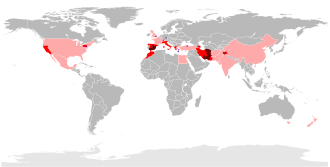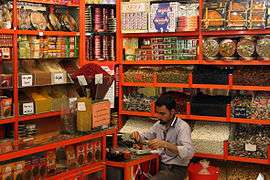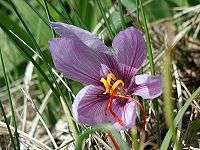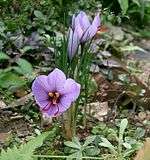Saffron (trade)
In the context of trade, saffron is one of the world's most expensive spices by weight,[1] saffron consists of stigmas plucked from the vegetatively propagated and sterile Crocus sativus, known popularly as the saffron crocus. The resulting dried "threads"[N 1] are distinguished by their bitter taste, hay-like fragrance, and slight metallic notes. The saffron crocus is unknown in the wild; its most likely precursor, Crocus cartwrightianus, originated in Crete or Central Asia;[2] The saffron crocus is native to Southwest Asia, and was first cultivated in the area now known as Greece.[3][4][5]
"Saffron, for example, was once less regarded than it is today because the crocus from which it is extracted was not particularly mysterious. It flourished in European locations extending from Asia Minor, where it originated, to Saffron Walden in England, where it was naturalised. Only subsequently, when its labour-intensive cultivation became largely centred in Kashmir, did it seem sufficiently exotic to qualify as one of the most precious of spices."[6]
Saffron crocus cultivation has long centered on a broad belt of Eurasia bounded by the Mediterranean Sea in the southwest to India and China in the northeast. The major producers of antiquity—Iran, Spain, India, and Greece—continue to dominate the world trade.
The cultivation of saffron in the Americas was begun by members of the Schwenkfelder Church in Pennsylvania. In recent decades cultivation has spread to New Zealand, Tasmania, and California. Iran has accounted for around 90–93 percent of recent annual world production and thereby dominates the export market on a by-quantity basis.[7]
Modern trade

| Producing regions: | major | minor |
| Producing nations: | major | minor |
| Trading centres: | present | past |

Producers
Almost all saffron grows in a belt bounded by the Mediterranean in the west and mountainous Kashmir in the east. All other continents except Antarctica produce smaller amounts. In 1991, Some 300 t (300,000 kg) of whole threads and powder are gleaned yearly,[8] of which 50 t (50,000 kg) is top-grade "coupe" saffron.[9]
Iran is by far the world's most important producer: in 2005 it grossed some 230 tonnes (230,000 kg) of dry threads, or 93.7 percent of the year's global total mass; much of the Iranian crop was bound for export.[7] Northeasterly Khorasan Province, which in 2004 was divided in three, grows 95 percent of Iranian saffron: the hinterlands of Birjand, Ghayen, Ferdows in South Khorasan Province, along with areas abutting Gonabad and Torbat-e Heydarieh in Razavi Khorasan Province, are its key cropping areas.[10] During 2004, Iran was not a member of the World Trade Organisation.[11] and still until November 2009, Iran was again not a member of the WTO.[12] Due to the state of affairs with regards to affairs of governments involved in political relations after the Islamic Revolution, Iran has remained a non-participant in the WTO, in-as-much, the country was kept from belonging to the organization from a time after the revolution onward.[11] EU sanctions and restrictions are in place for trading with Iran today.[13]
In 2004, second-ranked Greece produced 5.7 t (5,700.0 kg). Morocco and the disputed[N 2] region of Kashmir, tied as the next-highest producers, each produced 2.3 t (2,300.0 kg).[7] In decreasing order, Iran, Greece, Morocco, the Kashmir region in India, Azerbaijan, Spain, and Italy dominate the world harvest.
Afghanistan has resumed cultivation in recent years; in restive Kashmir it has waned.[14] Despite numerous cultivation efforts in such countries as Austria, England, Germany, and Switzerland, only select locales continue the harvest in northern and central Europe. Among these is the small Swiss village of Mund, in the Valais canton, whose annual saffron output amounts to several kilograms.[8] Microscale cultivation occurs in Tasmania,[15] China, Egypt, France, Israel, Mexico, New Zealand, Turkey (especially Safranbolu), California, and Central Africa.[4][16]
According to figures of 2014, India produced per annum about 15,000 kilograms.[17]
A protective geographical status, via the European Union, exists for growing, in the regions of, La Mancha, Spain, L'Aquila, Abruzzo, Italy, and around abouts Kozani, western Macedonia, Greece.[18] The Indian states of Jammu and Kashmir have the All J&K Saffron Growers & Dealers Association which is run in order to promote fair trade and the rights of saffron farmers, and to promote trade of the spice.[19][17]


Price
Factors determining costs
The high cost of saffron is due to the difficulty of manually extracting large numbers of minute stigmas, which are the only part of the crocus with the desired aroma and flavour. An exorbitant number of flowers need to be processed in order to yield marketable amounts of saffron. Obtaining 1 lb (0.45 kg) of dry saffron requires the harvesting of some 50,000 flowers, the equivalent of an association football pitch's area of cultivation, or roughly 7,140 m2 (0.714 ha).[20] By another estimate some 75,000 flowers are needed to produce one pound of dry saffron.[21] This too depends on the typical stigma size of each saffron cultivar. Another complication arises in the flowers' simultaneous and transient blooming. Since so many crocus flowers are needed to yield even derisory quantities of dry saffron, the harvest can be a frenetic affair entailing about forty hours of intense labour. In Kashmir, the thousands of growers must work continuously in relays over the span of one or two weeks throughout both day and night.[22]
Once extracted, the stigmas must be dried quickly, lest decomposition or mould ruin the batch's marketability. The traditional method of drying involves spreading the fresh stigmas over screens of fine mesh, which are then baked over hot coals or wood or in oven-heated rooms where temperatures reach 30–35 °C (86–95 °F) for 10–12 hours. Afterwards the dried spice is preferably sealed in airtight glass containers.[N 3][23]
Actual prices
Per gram, prices range upward to $65, according to a year 2015 evaluation,[24] £5.20 (La Mancha), according to an evaluation made during year 2014,[25] and €20, according to a year 2011 evaluation.[18] Bulk quantities of lower-grade saffron can reach upwards of US$500 per pound; retail costs for small amounts may exceed ten times that rate. In Western countries the average retail price is approximately US$1,000 per pound.[4] Prices vary widely elsewhere, but on average tend to be lower. The high price is somewhat offset by the small quantities needed in kitchens: a few grams at most in medicinal use and a few strands, at most, in culinary applications; there are between 70,000 and 200,000 strands in a pound.
A price set during 2014 for Saffron grown within England was £15 for 0.2. grams, this being sold at Fortnum & Mason, and a gram priced at a value with a maximum of £75.[26]
Saffron is somewhat renowned for sometimes costing more per weight than gold.[24][25]
Buyers
Experienced saffron buyers often have rules of thumb when deliberating on their purchases. They may look for threads exhibiting a vivid crimson colouring, slight moistness, and elasticity. They reject threads displaying the telltale dull brick-red colouring—indicative of old stock—and broken-off debris collected at the container's bottom, indicative of age-related brittle dryness. Such aged samples are most likely encountered around the main June harvest season, when retailers attempt to clear out the previous season's old inventory and make room for the new season's crop. Buyers recommend that only the current season's threads be used. Reputable saffron wholesalers and retailers will indicate the year of harvest or the two years that bracket the harvest date; a late 2002 harvest would thus be shown as "2002/2003".[27]
For the entire of 2013, the Guruvayur temple of India, known as particularly affluent, had an agreement with Jammu & Kashmir Agro Industries Development Corporation for the routine purchasing of an amount equal to 10 kg a month.[17]
Citations
- ↑ Raghavan 2006, p. 161.
- ↑ Rubio-Moraga et al. 2009.
- ↑ Grigg 1974, p. 287.
- 1 2 3 Hill 2004, p. 272.
- ↑ McGee 2004, p. 422.
- ↑ Keay (2005), pp. 19-20.
- 1 2 3 Ghorbani 2008, p. 1.
- 1 2 Katzer 2010.
- ↑ Negbi 1999, p. 2.
- ↑ Kafi et al. 2006, p. 24.
- 1 2 R. Rasti. Archived copy. published by American University Washington D.C. Archived from the original on 2016-03-10. Retrieved 2015-12-07. (Retrieved also 2015-12-09)
- ↑ status report published by The World Trade Organisation 2015 [Retrieved 2015-12-07]
- ↑ Governmental Office of the Crown of the United Kingdom – Business and enterprise – guidance Embargoes and sanctions on Iran First published : 11 September 2012 Last updated: 2 September 2015 published by The Crown [Retrieved 2015-12-09]
- ↑ Malik 2007.
- ↑ Courtney 2002.
- ↑ Abdullaev 2002, p. 1.
- 1 2 3 M. Thakkar. The Economic Times article. published by The Indian Times. Retrieved 2015-12-08.
- 1 2 J. S. Marcus. Wall Street Journal article. published by Dow Jones & Company, Inc. Retrieved 2015-12-07.
- ↑ Homepage Archived 2015-12-08 at the Wayback Machine. published by SGDA Saffron City Pampore [Retrieved 2015-12-08]
- ↑ Hill 2004, p. 273.
- ↑ Rau 1969, p. 35.
- ↑ Lak 1998.
- ↑ Negbi 1999, p. 8.
- 1 2 K. Monks. article. published by CNN September 3, 2015. Retrieved 2015-12-07.
- 1 2 P. Levy. article. published by The Telegraph November 7, 2014. Retrieved 2015-12-07.
- ↑ L. Crossley – article published by The Mail Online November 6, 2014 [Retrieved 2015-12-07]
- ↑ Hill 2004, p. 274.
Notes
- ↑ Another term that denotes the stigmas.
- ↑ Most of the region's saffron is grown in the more climatically suitable "Vale of Kashmir", which is under Indian control; the far more rugged "Gilgit-Baltistan" and "Azad Kashmir" areas under Pakistani control produce lesser quantities.
- ↑ Pure saffron stigmas will often be mixed with stamens to add "dead"—read: "worthless"—weight. To put it mildly, stamens have little culinary appeal but will still add the signature yellow color of saffron. Powdered saffron should be red-orange rather than yellowish in colour.
References
Books
- Dalby, A. (2002), Dangerous Tastes: The Story of Spices (1st ed.), University of California Press, ISBN 978-0-520-23674-5
- Grigg, D. B. (1974), The Agricultural Systems of the World (1st ed.), Cambridge University Press, ISBN 978-0-521-09843-4
- Hill, T. (2004), The Contemporary Encyclopedia of Herbs and Spices: Seasonings for the Global Kitchen (1st ed.), Wiley, ISBN 978-0-471-21423-6
- Kafi, M.; Koocheki, A.; Rashed, M. H.; Nassiri, M. (eds.) (2006), Saffron (Crocus sativus) Production and Processing (1st ed.), Science Publishers, ISBN 978-1-57808-427-2
- Keay, John (2005): The Spice Route: A History. John Murray, U.K. ISBN 0 7195 6805 6
- Major, J. (1892), "A History of Greater Britain as well England as Scotland", Publications of the Scottish History Society, University Press, 10
- McGee, H. (2004), On Food and Cooking: The Science and Lore of the Kitchen, Scribner, ISBN 978-0-684-80001-1
- Negbi, M. (ed.) (1999), Saffron: Crocus sativusL., CRC Press, ISBN 978-90-5702-394-1
- Raghavan, S. (2006), "Saffron", Handbook of Spices, Seasonings, and Flavorings (2 ed.), CRC Press, ISBN 978-0-8493-2842-8
- Rau, S. R. (1969), The Cooking of India, Foods of the World, Time-Life Books, ISBN 978-0-8094-0069-0
- Willard, P. (2002), Secrets of Saffron: The Vagabond Life of the World's Most Seductive Spice, Beacon Press, ISBN 978-0-8070-5009-5
Journal articles
- Abdullaev, F. I. (2002), "Cancer Chemopreventive and Tumoricidal Properties of Saffron (Crocus sativus L.)", Experimental Biology and Medicine, 227 (1), pp. 20–5, doi:10.1177/153537020222700104, PMID 11788779, retrieved 11 September 2011
- Assimopoulou, A. N.; Papageorgiou, V. P.; Sinakos, Z. (2005), "Radical Scavenging Activity of Crocus sativus L. Extract and Its Bioactive Constituents", Phytotherapy Research, 19 (11), pp. 997–1000, doi:10.1002/ptr.1749, PMID 16317646
- Boskabady, M. H.; Ghasemzadeh Rahbardar, M.; Nemati, H.; Esmaeilzadeh, M. (2010), "Inhibitory Effect of Crocus sativus (Saffron) on Histamine (H1) Receptors of Guinea Pig Tracheal Chains", Die Pharmazie, 65 (4), pp. 300–5, PMID 20432629
- Chang, P. Y.; Kuo, W.; Liang, C. T.; Wang, C. K. (1964), "The Pharmacological Action of 藏红花 (zà hóng huā—Crocus sativus L.): Effect on the Uterus and Estrous Cycle", Yao Hsueh Hsueh Pao, 11
- Chryssanthi, D. G.; Dedes, P. G.; Karamanos, N. K.; Cordopatis, P.; Lamari, F. N. (2011), "Crocetin Inhibits Invasiveness of MDA-MB-231 Breast Cancer Cells via Downregulation of Matrix Metalloproteinases", Planta Medica, 77 (2), pp. 146–51, doi:10.1055/s-0030-1250178, PMID 20803418
- Deo, B. (2003), "Growing Saffron—The World's Most Expensive Spice" (PDF), Crop and Food Research, New Zealand Institute for Crop and Food Research (20), archived from the original (PDF) on 27 December 2005, retrieved 10 January 2006
- Dharmananda, S. (2005), "Saffron: An Anti-Depressant Herb", Institute for Traditional Medicine, archived from the original on 26 September 2006, retrieved 10 January 2006
- Ghorbani, M. (2008), "The Efficiency of Saffron's Marketing Channel in Iran" (PDF), World Applied Sciences Journal, 4 (4), pp. 523–527, ISSN 1818-4952, retrieved 3 October 2011
- Gout, B.; Bourges, C.; Paineau-Dubreuil, S. (2010), "Satiereal, a Crocus sativus L. Extract, Reduces Snacking and Increases Satiety in a Randomised Placebo-Controlled Study of Mildly Overweight, Healthy Women", Nutrition Research, 30 (5), pp. 305–13, doi:10.1016/j.nutres.2010.04.008, PMID 20579522
- Hasegawa, J. H.; Kurumboor, S. K.; Nair, S. C. (1995), "Saffron Chemoprevention in Biology and Medicine: A Review", Cancer Biotherapy, 10 (4), pp. 257–64, PMID 8590890
- Hosseinzadeh, H.; Karimi, G.; Niapoor, M. (2004), "Antidepressant Effect of Crocus sativus L. Stigma Extracts and Their Constituents, Crocin and Safranal, In Mice", Acta Horticulturae, International Society for Horticultural Science (650), pp. 435–445, doi:10.17660/actahortic.2004.650.54, retrieved 23 November 2009
- Nair, S. C.; Pannikar, B.; Panikkar, K. R. (1991), "Antitumour Activity of Saffron (Crocus sativus)", Cancer Letters, 57 (2), pp. 109–14, doi:10.1016/0304-3835(91)90203-T, PMID 2025883
- Rubio-Moraga, A.; Castillo-López, R.; Gómez-Gómez, L.; Ahrazem, O. (2009), "Saffron Is a Monomorphic Species as Revealed by RAPD, ISSR, and Microsatellite Analyses", BMC Research Notes, 2, p. 189, doi:10.1186/1756-0500-2-189, PMC 2758891, PMID 19772674
Miscellaneous
- Courtney, P. (2002), "Tasmania's Saffron Gold", Landline, Australian Broadcasting Corp. (published 19 May 2002), retrieved 29 September 2011
- Katzer, G. (2010), "Saffron (Crocus sativus L.)", Gernot Katzer's Spice Pages, retrieved 3 December 2012
- Lak, D. (1998), "Kashmiris Pin Hopes on Saffron", BBC News (published 11 November 1998), retrieved 11 September 2011
- Malik, N. (2007), Saffron Manual for Afghanistan (PDF), DACAAR Rural Development Program, archived from the original (PDF) on 9 September 2011, retrieved 17 September 2011
- Park, J. B. (2005), "Saffron", USDA Phytochemical Database, archived from the original on 25 September 2006, retrieved 10 January 2006
- Tom, N. (2015), "About saffron trade", ULBIRAN (published 15 November 2015), archived from the original on 2016-08-15, retrieved 19 July 2016